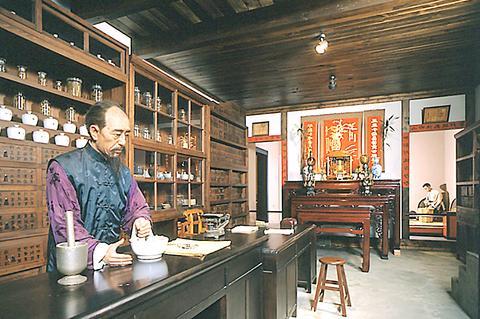While all too many exhibitions relating to China's social, agricultural and scientific developments rely on yellowing pages of drab printed matter and a few lifeless artifacts, The National Museum of Science's (
Divided into six units, the exhibition rooms give visitors an insightful glimpse into Chinese scientific and technological discoveries, early irrigation and farming techniques, religion, medicine, spirituality and the area's indigenous peoples.
The hall's central and most breathtaking unit is that dedicated to science and technology. Here visitors get to view artifacts and -- at the touch of a button -- can listen to commentaries explaining the history of early experiments with gunpowder, the earliest forms of printing and the invention of the compass. While all very interesting, it is the exhibition hall's impressive collection of models that make for the most fascinating viewing.

PHOTO COURTESY OF THE NATIONAL MUSEUM OF SCIENCE
Wooden scaled-down replicas of sand junks show how Chinese shipbuilders employed bulkheads, a model of a 13th century Equatorial Torquetum shows how early astronomers determined the locations of constellations and a reconstruction of a Tang Dynasty (618 to 907) structure lets visitors see how Chinese construction was developed.
Although all the models are remarkable, the most striking is the huge working replica of a water-powered armillary sphere, which was invented during the northern Sung Dynasty (960 to 1127) and used to tell both the time and make astronomical observations. The 12m high true-to-scale fully functional wooden model is an exact copy of one that stood in the imperial palace in 1088.
Moving on from technology and science, the Chinese Medicine hall gives visitors insight into the development of herbal medicine and oriental therapies such as acupuncture. This area includes an informative film, which tells of the therapeutic values of flora, and shows some rather gruesome early healing tools.
The only part of the exhibition that deals in any depth with Taiwan is the Taiwan Aborigines and Austronesian area, where wax dummies bedecked in the traditional costumes of Taiwan's dozen Aboriginal tribes pale in comparison with the Science Hall's other more creative and accurate models.
Possibly the hall's least visited -- but it is still an insightful exhibition space -- is the Agricultural Development section. Well organized and sometimes free of screaming children, the area includes a selection of early farming implements dating back to the eastern Han Dynasty (25 to 220) and a collection of stone inscriptions portraying early farming methods.
While the exhibition is not without its faults (no English-language material is one irritation), a visit to The National Museum of Science's Chinese Hall makes for an interesting hour or so.

Behind a car repair business on a nondescript Thai street are the cherished pets of a rising TikTok animal influencer: two lions and a 200-kilogram lion-tiger hybrid called “Big George.” Lion ownership is legal in Thailand, and Tharnuwarht Plengkemratch is an enthusiastic advocate, posting updates on his feline companions to nearly three million followers. “They’re playful and affectionate, just like dogs or cats,” he said from inside their cage complex at his home in the northern city of Chiang Mai. Thailand’s captive lion population has exploded in recent years, with nearly 500 registered in zoos, breeding farms, petting cafes and homes. Experts warn the

The unexpected collapse of the recall campaigns is being viewed through many lenses, most of them skewed and self-absorbed. The international media unsurprisingly focuses on what they perceive as the message that Taiwanese voters were sending in the failure of the mass recall, especially to China, the US and to friendly Western nations. This made some sense prior to early last month. One of the main arguments used by recall campaigners for recalling Chinese Nationalist Party (KMT) lawmakers was that they were too pro-China, and by extension not to be trusted with defending the nation. Also by extension, that argument could be

Aug. 4 to Aug. 10 When Coca-Cola finally pushed its way into Taiwan’s market in 1968, it allegedly vowed to wipe out its major domestic rival Hey Song within five years. But Hey Song, which began as a manual operation in a family cow shed in 1925, had proven its resilience, surviving numerous setbacks — including the loss of autonomy and nearly all its assets due to the Japanese colonial government’s wartime economic policy. By the 1960s, Hey Song had risen to the top of Taiwan’s beverage industry. This success was driven not only by president Chang Wen-chi’s

Last week, on the heels of the recall election that turned out so badly for Taiwan, came the news that US President Donald Trump had blocked the transit of President William Lai (賴清德) through the US on his way to Latin America. A few days later the international media reported that in June a scheduled visit by Minister of National Defense Wellington Koo (顧立雄) for high level meetings was canceled by the US after China’s President Xi Jinping (習近平) asked Trump to curb US engagement with Taiwan during a June phone call. The cancellation of Lai’s transit was a gaudy